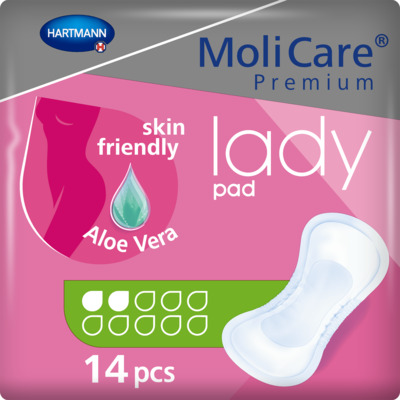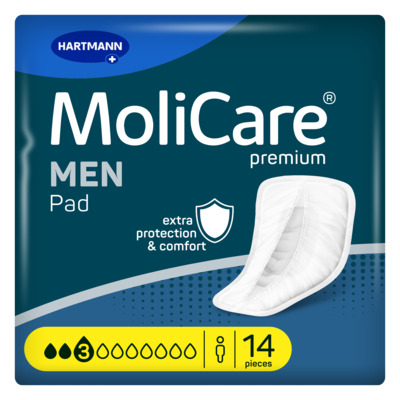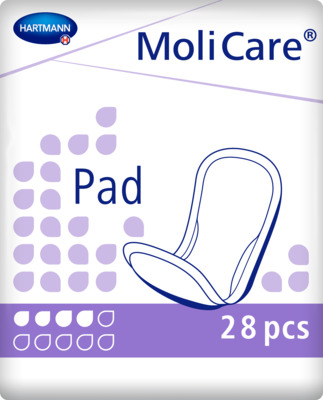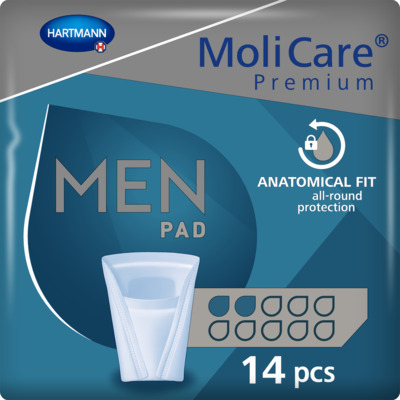Incontinence Advice
Urinary incontinence: these are the causes
Do you struggle with uncontrollable urges to pee? You're not alone. Millions of people suffer from urinary incontinence, and the causes can be diverse - from nerve damage to infections. But have you ever wondered how it all starts?
In this article, we'll dive into the fascinating world of the urinary tract and uncover the root causes of bladder weakness. Get ready to take control of your bathroom breaks. If you are suffering from incontinence then feel free to browse our range of adult incontinence pants.

How urinary incontinence can develop
Normally, we empty our bladder between four to seven times a day in response to the urge to go to the toilet. Behind this process is a complicated interaction between the bladder and the nervous system. If this is impaired, those affected may develop urinary incontinence.
Small children learn in the first years of their lives how to deliberately control the emptying of their bladders. This is also known by the Latin term, miction. This ability to control our bladders allows us to take part in social life, ideally all the way through to an advanced age.
Unfortunately, the complex process of voluntary emptying of the bladder is susceptible to problems. These include certain neurological diseases such as multiple sclerosis, as well as the natural ageing process. A typical symptom of all types of urinary incontinence is involuntary loss of urine, whether in response to stresses such as sneezing or jumping, when lifting heavy objects or without any apparent cause (read more about stress incontinence in women)
In this article
Products for women
Take a look at our incontinence products for women
Common causes of urinary incontinence:
In men prostate surgery is one of the most common causes of urinary incontinence because the surgery usually includes removal of part of the sphincter muscle. Even before the removal of their prostate, men also often experience overflow incontinence (chronic urinary retention) in which a part of the urethra is constricted or blocked by the prostate.
For women pregnancy as well as the hormonal changes prior to menopause (perimenopause) weaken the pelvic floor and can thus cause bladder weakness. There is an involuntary loss of urine, often in the form of stress incontinence, which can impact you in the day or at night. Read more about pregnancy and incontinence here >>
Because of the very different causes of incontinence, the first important step in treating bladder weakness is to identify with your doctor what the underlying problem is. Only the right diagnosis ensures that your therapy will be tailored to your individual needs and be successful. Modern treatment options and incontinence products enable you to cope with everyday life.
Let’s look now at the structure of the urinary tract and how bladder weakness can develop.
Anatomy and the function of the urinary tract
In women the bladder lies immediately in front of (slightly below) the uterus while in men it is next to the rectum. It is protected by the pelvis and is connected to the kidneys by the two ureters that fill the bladder with urine. When the bladder is filled to about half its capacity, special receptors signal the filling level to the brain. We now perceive an urge to go to the toilet that becomes stronger and stronger. Fortunately, the bladder is highly elastic, which means that in healthy state, urine can accumulate further over a longer period.
The capacity of the bladder varies enormously from person to person and depends in part on the size of the body.
We can consciously empty a full bladder primarily thanks to the powerful sphincter muscle that can be deliberately relaxed as soon as urine is to be released. The pelvic floor muscles support the sphincter muscles and hold the urethra and neck of the bladder in position.
A healthy urinary tract prevents involuntary loss of urine even if the bladder is full or is subjected to stressors such as sneezing, coughing or physical exertion.

Function of the bladder
The formation and excretion of urine are essential processes for the body and serve the following purposes:
- Elimination of urinary waste products from the blood
- Regulation of the fluid balance in the body
- Maintenance of the acid-base balance in the body
How much urine is formed each day depends not only on the volume of fluids taken in but also on the functionality of the kidneys. Even fluids that are excreted in sweat, breath or the water content of stool affect the volume of urine produced. The average volume of urine according to Apotheken Umschau1 in adults is 1 to 1.5 litres per day.
Check out our article "Overactive Bladders – What You Need To Know"
The pelvic floor and its importance for incontinence
The pelvic floor can be thought of as an upside‑down umbrella that is stretched between the pelvic bones and supports the bladder and the other organs of the lower abdomen. The pelvic floor muscles is made up of several muscle bundles that form the outer sphincter muscle that can be deliberately relaxed to release urine. Together with the inner sphincter muscle on the neck of the bladder, these muscles ensure that the bladder is closed when tensed.
The lower urinary tract with the bladder, urethra and sphincter system therefore has two functions that it must fulfil:
- the storage of urine and
- the controlled release of urine (miction).
Along with an intact bladder and sphincter muscles, a functioning nerve supply is also required.
Particularly with increasing age and, for example, after pregnancy, the muscles in the pelvic floor become weakened in many people. They can no longer perform their function, leading more and more often to the involuntary loss of urine as a symptom of urinary incontinence. However, weak pelvic floor muscles can be specifically trained, just like many other muscles in our bodies. You can learn more here about pelvic floor training.
Some neurological disorders such as stroke also disrupt the communication along the nerves between the urinary tract and the brain.
What happens when the bladder is emptied
Thanks to the elastic muscles of the bladder wall, we only notice that the bladder is filling above a certain increase in pressure. If the urinary tract is healthy, the sphincter muscle system holds the opening of the urethra firmly closed during this filling phase.
If the bladder continues to be filled, then the bladder sends more and more nerve impulses that travel along the nerve pathways in the spinal cord to the miction centre in the brain stem and from there to the higher brain centres. As soon as these nerve impulses reach a certain intensity, we perceive them as the urge to urinate. In healthy people this usually occurs with a volume of about 130 to 150 ml.2 If the urinary tract is healthy, at this point the urge to urinate can be suppressed for a while until it becomes much stronger or it is possible to go to the toilet.
The emptying of the bladder can now be deliberately started by issuing the appropriate ‘commands’ from the brain to contract the bladder muscles. They force the urine out of the bladder and open the inner sphincter muscle while at the same time the pelvic floor muscles relax. As a result, the outer sphincter muscle also now opens and the urine is released. The control by the miction centre means that it is also possible to initiate the emptying of the bladder even if the bladder only contains a small volume of urine and not when there is a strong urge to urinate.
As a rule, adults must empty their bladder about four to seven times a day, depending on the capacity of their bladder, their age and the volume of liquids taken in. One trip to the toilet over night is also considered normal. Older people have to empty their bladders more often than younger people because of a smaller bladder capacity.3
Possible reasons for problems with urination
You can probably already guess how susceptible to problems the complex process of urine storage and urination is. In a nutshell, there are four reasons that lead to problems with continence:
- The sphincter muscle system no longer has enough closing force.
- The bladder muscles tense up too much or not enough.
- An obstruction (such as an enlarged prostate) in the urethra prevents emptying of the bladder.
- The transmission of the nerve impulses between the bladder, spinal cord and brain is wholly or partly disrupted.
These functional problems related to urination in turn result from a wide range of triggers and lead to incontinence of varying severity in those affected. We wrote a post about new ways to talk about incontinence for you to read. Read the article
The fault may lie with urinary tract infections, a weak pelvic floor or an enlarged prostate, for example. Changes in the brain, metabolic disorders, spinal cord injuries or the effects of medications can also cause problems.

Different types of incontinence
Based on the various functional disorders, urinary incontinence is classified into different types.
The most common types are:
- stress incontinence,
- urge incontinence (which is also commonly referred to as an overactive bladder, we wrote a new article about it. Click here to read more
- overflow incontinence (incontinence with chronic urinary retention)
In old age, a weak bladder is rarely due to only one of the different causes listed above and is therefore also known as mixed incontinence. Several factors play a role here. In addition to urinary incontinence, faecal incontinence can also occur in older people but this is considerably rarer and can be managed with bowel incontinence products.
Regardless of the type of incontinence, those affected can only be effectively helped if the cause of the problem is known. It is therefore important that a doctor accurately diagnoses the disorder and the type of urinary incontinence and tailors the treatment to the needs of the patient and the severity of the bladder weakness. For this reason a physical examination is essential.
With the appropriate therapy and the use of reliable incontinence products, an active life is still possible even with bladder weakness. Take the first step today and make an appointment with your doctor.
Sources
1 "="">https://www.prostata.de/prostata/beschwerden/harninkontinenz#:~:text=%C3%9Cberlaufinkontinenz%20(Ischuria%20paradoxa)%3A%20Urinverlust,auch%20Miktionsst%C3%B6rungen).
2 https://prostata-hilfe-deutschland.de/gutartige-prostatavergroesserung-bph/
4 https://prostata-hilfe-deutschland.de/inkontinenz-prostatakrebs-behandlung/

MoliCare® Premium Lady Pad 2 Drops
<h2>Skin Friendly Pant Liners</h2> <p>For women that experience slight incontinence and bladder weakness, across different age groups, it can be a challenge to find the right bladder weakness product that is easy to apply and wear without the worry of potential leakages. Fortunately, we understand this approach, hence why we are happy to offer our MoliCare® Premium Lady Pad 2 drops, that is skin-friendly, Aloe Vera applied, and comes with 14 liners per bag.</p> <h2>Slim and discreet liners</h2> <p>Whether dealing with stress incontinence or urge incontinence, these panty liners offer a discreet and easy solution on the go. Simply place the pad in your underwear and secure it with the adhesive strip for all-round protection. Available in different absorbency levels, MoliCare® bladder weakness products cater to all levels of bladder weakness, ensuring secure care.</p> <h2>Control Bladder Weakness</h2> <p>Enjoy the benefits of these body-shaped absorbent panty liners, designed for women with bladder weakness. The pads offer discreet, reliable protection with features including odour control and fast absorption.</p> <p>With a wide adhesive strip, you can comfortably fix the pad in your regular underwear, providing secure and comfortable fixation. The pads are skin-friendly, featuring soft, breathable materials, including foam cuffs, and a top sheet treated with Aloe Vera.</p> <p>Keeping your skin healthy is a priority, which is why MoliCare® Premium Lady Pads have a skin-neutral pH value of 5.5 and an antibacterial finish. They are also dermatologically tested, offering peace of mind.</p> <h2>Buy pant liners online</h2> <p>Never worry about running out with our convenient order service and fast delivery direct to your door. Enjoy free shipping on orders over £50.</p> <p>If you need assistance, our professional customer service team is here to support you in choosing the right product. Reach out to us today at 0800 028 9470 and experience the comfort and reliability of MoliCare® Premium Lady Pads.</p>
MoliCare® Premium Men Pad 3 Drops (ISO 441ml)
<p><strong>Reliable and discreet incontinence pads for men with an instant-dry feeling</strong></p> <p>Bladder weakness is difficult to live with, the last thing you want to worry about is incontinence protection. That’s why our best-ever MoliCare® premium MEN Pad 3 drops offer an <strong>all-round protection</strong> that keeps everything dry and comfortably in place while fitting discreetly in your regular underwear.</p> <p>The incontinence pad for men quickly <strong>removes urine from the surface up to 86 %* faster than before</strong> and neutralises unpleasant odours to leave you feeling instantly dry and in control thanks to the new <strong>MoliCare SkinGuard</strong>®<strong> Absorbent Core Technology</strong>. This skin-friendly technology not only helps you feel up to 90 %* drier than previous MoliCare® premium<strong> </strong>MEN pads, it also helps to maintain healthy skin and preventing irritation.</p> <p><strong>Engineered for the male anatomy</strong> and dermatologically tested for maximum skin compatibility, these male urinary pads do not contain colour, perfume or latex making them environmentally friendly too.</p> <p>*Compared to last generation</p>
MoliCare® Pad 4 Drops
<h2>Handy MoliCare incontinence pads to carry on the go</h2> <p>Our MoliCare® Pad 4 Drops are an essential product for those experiencing slight incontinence, allowing you to regain control and live your busy and active life without the interference of bladder weakness. Designed for both men and women, this incontinence pad for men and women offers exceptional dryness and protection, ensuring your comfort and confidence.</p> <h2>‘Barely There’ Reassurance and Reliability</h2> <p>The MoliCare® Pad 4 Drops are slimline, discreet, and adjusted to fit your body seamlessly. It fixes securely inside your underwear, providing a ‘barely there’ comfort feel. With its soft and skin-kind fabric, along with a wide adhesive fixing strip on the backsheet, you can go about your day with the assurance of being protected against leakages.</p> <p>The absorbent core effectively prevents your skin from becoming too moist, while the elastic anti-leak edging adds an extra layer of security and peace of mind. Say goodbye to any worries about odours, as the MoliCare® Pad 4 Drops also neutralises odours to keep you fresh and confident throughout the day. Don't let incontinence hold you back from living life to the fullest.</p> <p>Ordering your MoliCare® Pad 4 Drops is hassle-free, as we offer fast delivery direct to your door. With our price match promise, you can trust that you're getting the best value for your money. Plus, enjoy free delivery on all orders over £50.</p> <p>If you need assistance in finding the perfect incontinence product for your needs, our friendly customer care team is here to help. Don't hesitate to reach out to us at 0800 028 9470. Take control of your life with the reliable protection and comfort of the MoliCare® Pad, alongside other <a href="https://www.hartmanndirect.co.uk/incontinence-products/incontinence-pads" style="color:#0563c1; text-decoration:underline">incontinence pads</a>.</p>
